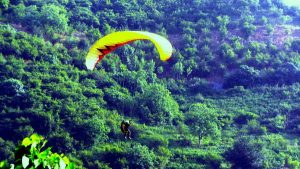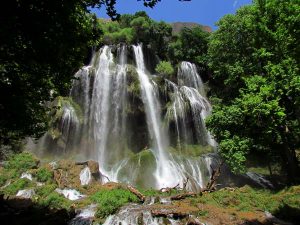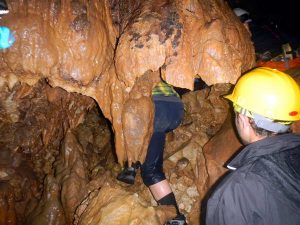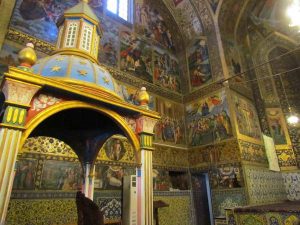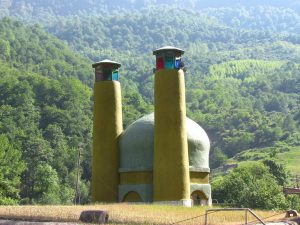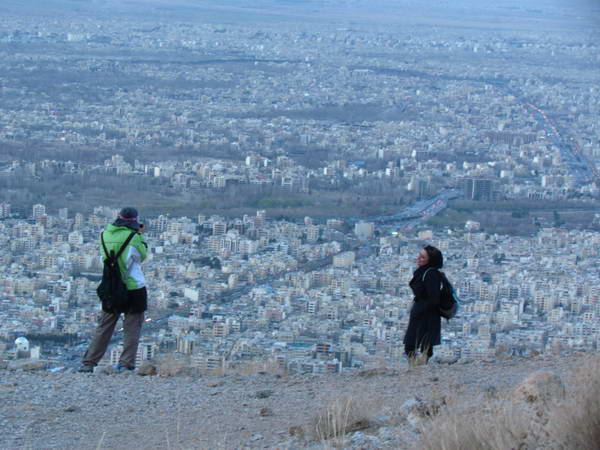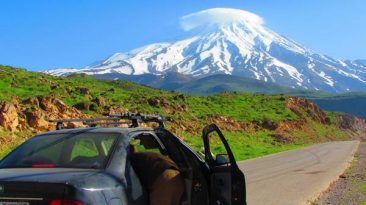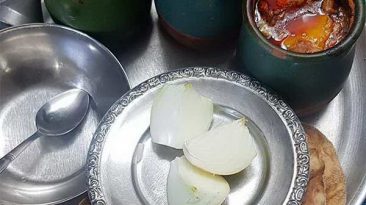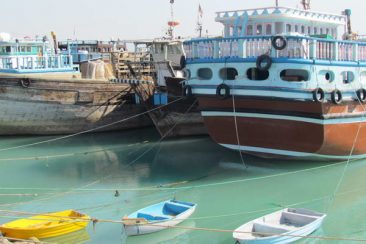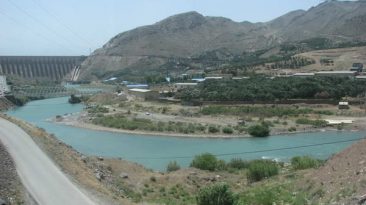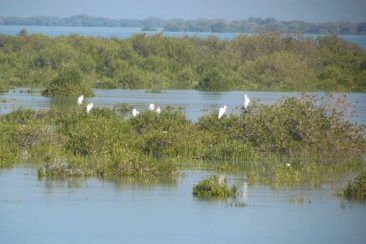Tang-e Chogan and the remnants of ancient Bishpur city are close together and are the among the most famous historical sites in Kazerun county of Fars province.
Kazerun region, once there was one of the capitals of the Sassanid governments and since then, many historical monuments have remained in this region. Historical monuments that are mostly in the form of reliefs in the wall of the mountains of this region and this is the secret of their permanence.
Among the Sassanid historical monuments are the reliefs on the wall of the mountain in Tang-e-Chogan, as well as the ancient city of Bishapour and the huge statue of Shapur at the mouth of Shapur Cave.
All the above-mentioned historical monuments are close to each other, about 25 km north of Kazerun city and south of Qaemieh town. The best way to reach them is from Ghaemieh town, which is located in the middle of Yasuj-Borazjan road.
Huge reliefs have been carved into the walls of the Tang-e Chogan (Chogan gorge), depicting the investiture ceremonies of Bahram and Shapur, the Sassanid emperors, and the donation of booty, gifts, and also prisoners of war (Roman emperors).
Lovers of pre-Islamic Iranian history and culture should visit this historical complex, including the ancient city of Bishapour, the Tang-e Chogan and the statue of Shapur.
In the following, I will bring information and images related to the six reliefs of the Sassanid period that exist in the Tang-e Chogan. This information and pictures belong to the Sassanid Archaeological Landscape of Fars Region.
Google map link of Tang-e Chogan
The First Relief of Shapur I
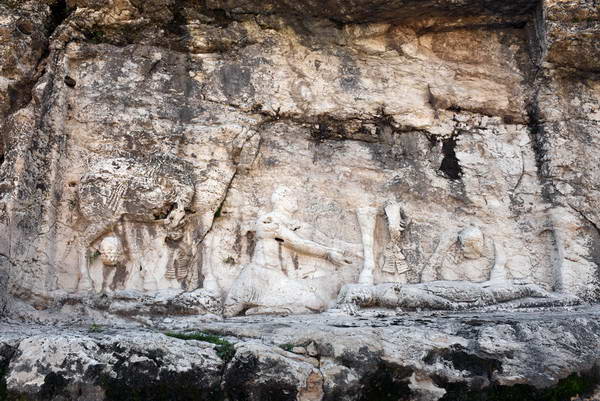
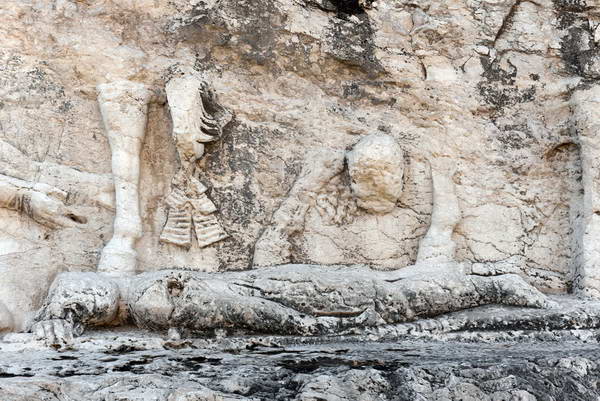
The first and indeed one of the earliest reliefs of Shapur has been carved on the left bank of Tang-e Chogan and consists of a combined scene of investiture and triumph executed in a style characteristic of the period of Ardashir. The king receives a diadem from Ohrmazd. Both figures are mounted and facing each other; the god’s horse tramples a prone figure interpreted as Ahriman beneath its hooves, and the king’s horse crushs the slain Roman emperor Gordian III. Philip the Arab, kneeling and suppliant, is the only other figure represented. The fact that Valerian is not included in this relief suggests that it should be dated before his defeat and captivity in 260, perhaps even before the formal foundation of the city.
The Second Relief of Shapur I
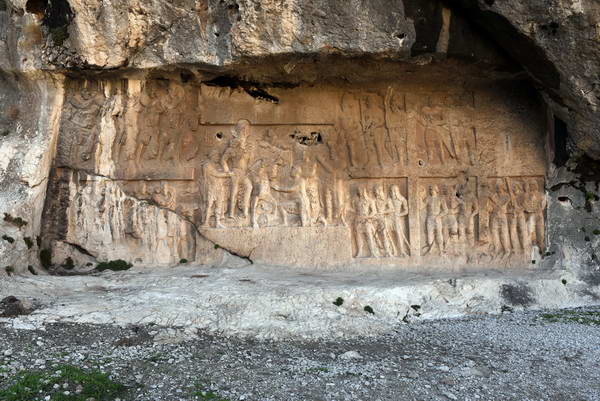
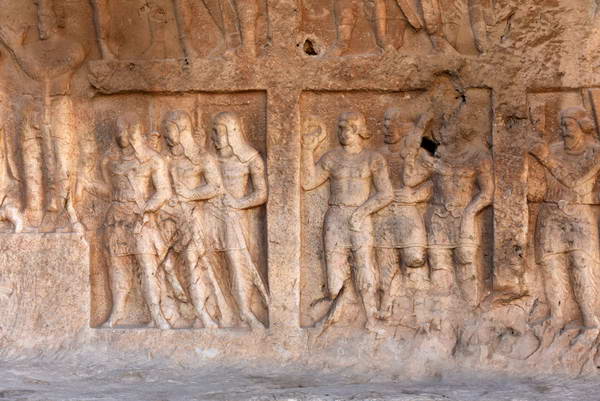
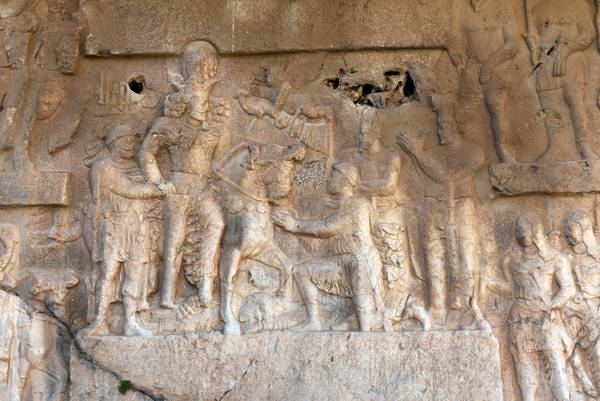
Shapur’s second relief in Tang-e Chogan has been depicted on a sheltered concave surface cliff on the left bank of the river. The surface measures 12.20 by 4.60 meters on which Shapur I is seen in profile wearing a crenelated crown topped with a big ball. The relief reflects a new formula for the representation of triumph: In the center, the mounted king -Shapur- receives the diadem, not from the god but from a putto, an obvious borrowing from Western iconography. Gordian is shown beneath the horse’s hooves and Philip kneeling, while Shapur grasps Valerian by the wrist. Tiers of horsemen flank this scene and above it a naked boy is hovering like a small winged angel carrying a half-crown for the king. In a well-known inscription called ‘Zoroaster’s Caaba’ Shapur claims:” near the borders of Asurestan in the city of messiah a huge battle flared up, Kaiser Gordianos was murdered and the Roman army dispersed…” Despite the fact that the Roman influence is seen in the lively style of this relief, its overall format represents continuation of an old Near Eastern formula for depicting several events in a single composition.
The Third Relief of Shapur in Tang-e Chogan
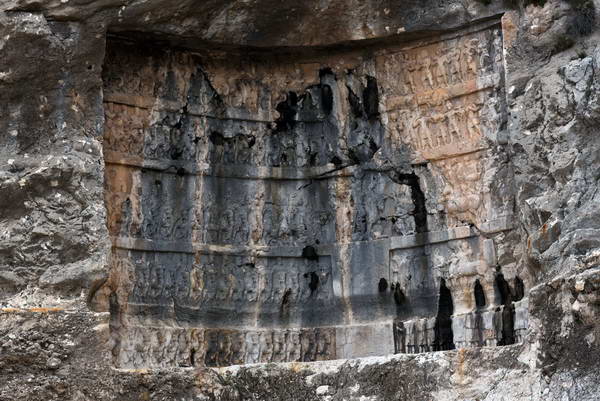
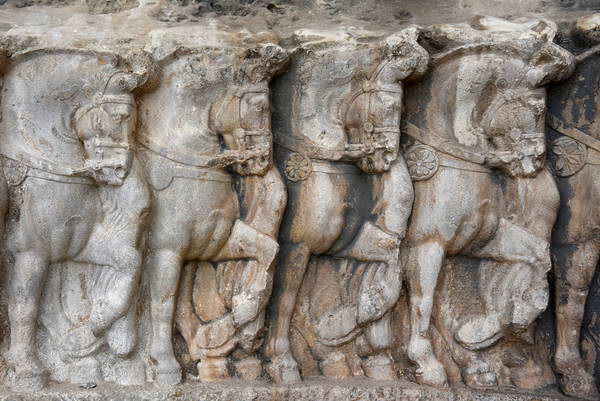
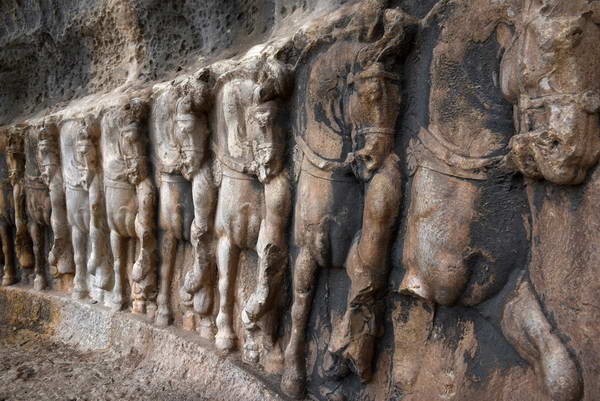
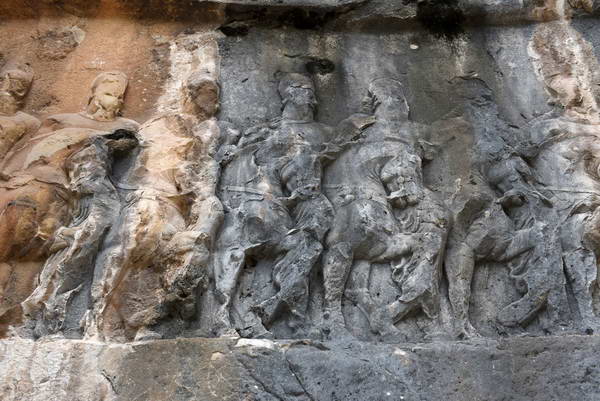
The third relief regarding the victory of Shapur I over the Roman emperors has been carved on the right side of the Shapur River and like the second relief (on the left bank of the river), the scenes of Shapur’s victory over the Roman emperors are demostrated. This relief was carved on a nearly square and curved surface of the mountain, in which more than 100 people have been involved. The body of Shapur I is carved in the center of the scene, and the angel of victory grants him the special ribbon for kingdom. Between the legs of Shapur I’s horse, has fallen the dead body of Gordianos III, and in front of the horse, the other Roman emperor, Phillip the Arab is seen kneeling and begging for peace and tranquility. Riding a horse, Shapur has been depicted holding Valerian’s hand as a captive. In front of Shapur and next to Philip the Arab, two people are standing. One of them has a long Iranian hat, and the other, dressed in the Roman style, presents the victory ring to the king. On the right hand side of the scene, Iranian commanders and soldiers have been presented in five lines. In front of them and on the left side of the scene, the Romans are seen also in five lines, offering gifts such as elephants, horses and utensils such as pans, cups, jars, bowls, flags as well as other objects even a warrior chariot. On top of these images, there are those who are probably bringing gold coins, silverware, crowns and two lions. In this scene, all of the 71 Iranian commanders are mounted. Unfortunately the long-lasting water flow over and next to some of the first rows of motifs from the bottom has gradually erased all the heads depicted in this row.
Investiture Relief of Bahram I
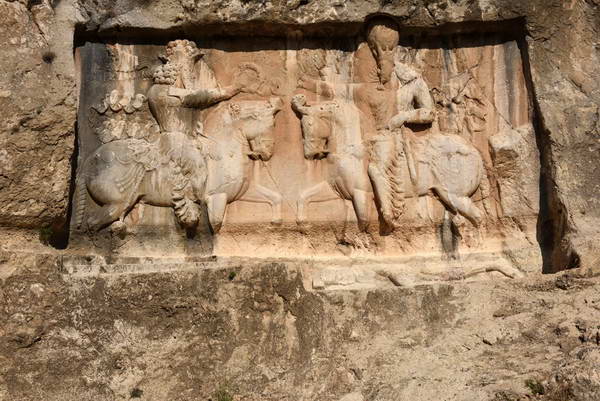
This stone relief is carved on the rocks of the right bank of the Shapur River, and its theme is about the reception of the the royal ring by Bahram I (271-274) from Ahura Mazda. In this stone relief, Ahura Mazda is seen mounted on the left side of the picture (from the viewer’s perspective) while wearing a crenelated crown and holding the royal ring toward Bahram. On the right side of the image, Bahram I is shown riding a beautiful horse. He wears a crown that has several beam-like blades, and also, unlike the Ahura Mazda, is armed with a long sword on his waist. Accouterments of both Ahoura Mazda’s and Bahram’s horses are similar to each other. This image is one of the most beautiful reliefs belonging to the Sasanian period. Stonecuts are quite artistic and harmonious, and the wrinkles and movement of clothes and other details (even the veins on the horse’s foot) are finely shown. The written inscription on the image of Bahram was originally as follows: “This is the image of the praiser of Ahoura Mazda, Bahram the king of kings of Persia and beyond.” However, for the first time, the German archaeologist Ernst Hertzfeld has discovered that during the rule of Narseh (293-302 AD), due to family disputes between Narseh and Bahram over the succession of their father, Shapur I, the name of Bahram was removed and was substituted by Narseh in the inscription.
The First Relief of Bahram II in Tang-e Chogan
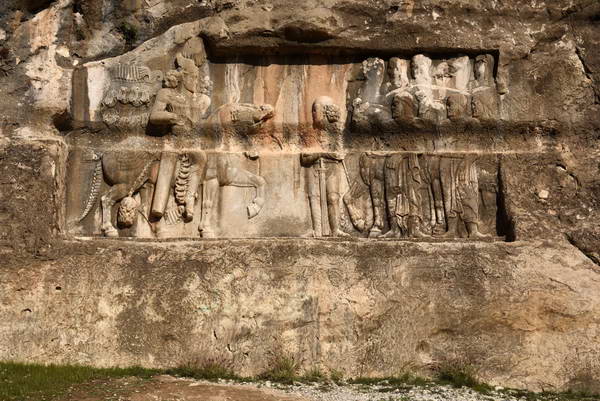
In this stone relief, the Sassanian king – Bahram II (274-293 AD) is shown on horseback. He has a beard and long hair and is wearing a winged crown which looks like the wing of an eagle. The king also has a tight jacket, loose trousers and a cape over his shoulders so that both of its sides are attached to the jacket with two buttons. On the right side of Bahram, a heavy quiver dangles from his belt. The horse of the king is beautifully decorated and, as usual, in the Sassanian reliefs, a blanket is seen on the right side of the saddle. A commander is standing in front of the king, with a dress and hair style similar to the king, showing that he is either of a high rank or belongs to the royal family. The shape of his body has been depicted in full face and in such a way that both arms are placed over the abdomen and on the sword in a state of respect so that its long blade is perpendicular to the ground and between his legs. Behind him, three full-length Arab elders, and only heads and chests of three other people are visible. They are presented with gifts such as horses and camels in front of the king. All six are wearing long robes and a kind of Arabic headcover called kefiyeh.
The Second Relief of Bahram II
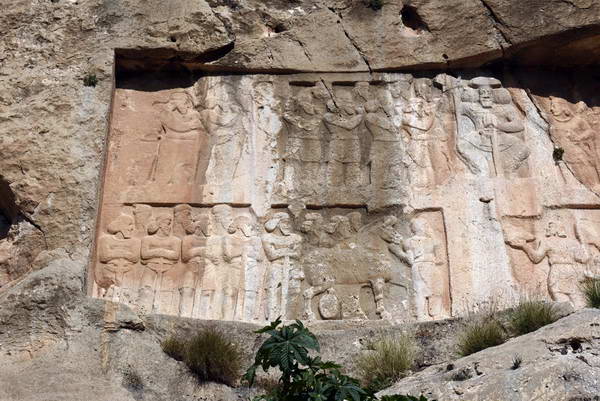

This relief which has been carved over a flat and rectangular surface with a diameter of 5/10 by 5 meters is the second major relief attributed to Bahram II (274-293 CE) in Tang-e Chogan. At the center of the scene and in the upper frame, the Sassanian king is siting on the throne, and in accordance with the eastern tradition, he is shown bigger and heavier than others. He is holding a flag with his right hand and a sword with his left hand wich is held vertically between his legs. On the right side of the king, the Sassanian rulers and commanders are shown while holding their right hands in front of their faces in an state of respect. On the left side of the king, in the upper part, some of the Parsians are bringing two captives to the presence of the king. In the lower part from the right hand of the king, a person is leading the horse of the king. Behind him, ten people consisting of the elders and commanders of Iran have been shown. Opposite the scene, on the left side of the Shah, eleven Iranian attendants and servants, along with a child who seems to have raised his hands in a state of supplication and obedience are seen. Among the eleven men, two executioners are presenting the heads of defeated enemies to the king. At the end of the scene, a carved elephant carries two riders on his back. Behind them are two people bringing gifts. There is a controversy in relation to the identity of the king sitting on the throne in this outstanding relief. Although some consider him as Shapur II, most of modern scholars think he is Bahram II, who is portraying his victory over a group of enemies or insurgents (probably the king of Sistan and Makran).

